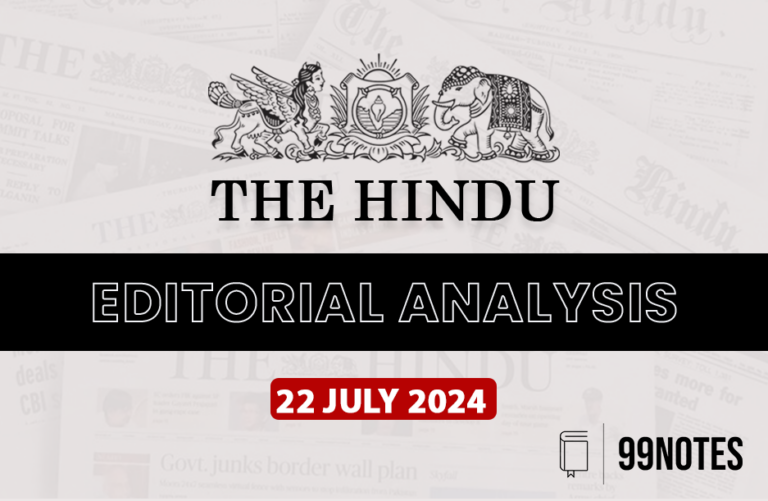22 April 2024 : The Hindu Editorial Notes PDF
The Hindu EDITORIAL
22-April-2024
1. Preparing India for water stress, climate resilience
|
Topic: GS3 – Environment – Environmental pollution and degradation GS1 – Geography – Distribution of Key natural resources Crucial for UPSC as it covers interdisciplinary issues like water governance, climate change, and sustainable development, aligning with current affairs. |
| Context |
| ● The article discusses India’s need for a holistic approach to address water stress, emphasizing the interconnections between water, food, energy, and climate resilience. |
Introduction:
- The India Meteorological Department (IMD) predicts a hotter summer and longer heat waves from April to June, emphasizing the need for preparedness for water stress.
- India’s approach to handling acute stresses like heat waves and water crises must shift from panic reactions to understanding and responding to the chronic nature of these risks.
- Climate action and environmental sustainability must encompass holistic approaches beyond short-term relief efforts.
Challenges and Context:
- India, with 18% of the world’s population but only 4% of global freshwater resources, faces significant water stress.
- Pollution affects nearly half of its rivers, and primary reservoirs are at low storage capacities.
- Climate change exacerbates the situation, with three-quarters of India’s districts being hotspots for extreme climate events.
Understanding the Intersections:
- Water connects various sectors of the economy, including hydrology, food, and energy, impacting millions of people.
- Precipitation influences soil moisture, vegetation, and water resources, crucial for agriculture, which employs 45% of India’s population.
- Changing rainfall patterns affect agriculture, highlighting the need for resilience against climate stresses.
Water’s Role in Energy Transition:
- Water is essential for producing green hydrogen and pumped storage hydropower, crucial for clean energy transitions.
- The increase in hydrometeorological disasters underscores the significance of freshwater management.
Ingredients of Water Security:
Effective Water Governance:
- Policies should recognize the interconnections between water, food, and energy systems.
- Considerations of water availability are necessary for scaling up initiatives like green hydrogen production and solar irrigation pumps.
Judicious Water Use:
- Focus on water accounting and efficient reuse to increase water use efficiency.
- Targets such as reducing non-revenue water in urban areas need baseline data for effective measurement.
Financial Tools for Adaptation:
- Increase funding for climate adaptation in the water and agriculture sectors.
- Financial instruments like India’s Green Credit Programme can incentivize investments in wastewater management and climate-resilient agricultural practices.
Conclusion:
- Systemic changes towards water security and climate resilience require coherence in policies, data-driven approaches for water savings, and innovative financial mechanisms.
- Transitioning to a water-secure economy is vital for India’s resilience against climate change impacts.
- This comprehensive approach underscores the urgency and complexity of addressing water stress and climate resilience in India.
| PYQ: Why is the world today confronted with a crisis of availability of and access to freshwater resources?(150 words/10m) (UPSC CSE (M) GS-1 2023) |
| Practice Question: Discuss the interconnected challenges of water stress, climate change, and sustainable development in India, and propose policy measures for enhancing water security. (150 Words /10 marks) |
2. The challenges of renewable energy
|
Topic: GS3 – Indian Economy – Infrastructure – Energy Critical for UPSC as it addresses interdisciplinary issues like renewable energy, sustainable development, climate change mitigation, and environmental governance. |
| Context |
| ● The article examines the complexities of integrating large-scale renewable energy projects, particularly solar parks, with development, sustainability, and climate change mitigation goals in India. |
Introduction:
- Simon Stiell, the United Nations Climate Change Executive Secretary, emphasizes the urgency of the next two years in addressing climate change.
- The linkages between development, sustainability, and climate change mitigation remain unclear, as current development models drive unsustainable greenhouse gas emissions.
Examining Solar Parks:
- Large-scale solar parks are central to India’s mitigation strategy, with potential implications for local and national development and sustainability goals.
- Local experiences in areas like Bhadla and Pavagada highlight varied impacts on farmers, including land loss, economic disparities, and water security concerns.
Resource Competition and Impacts:
- Solar parks may compete for essential resources like water and land with agriculture, potentially impacting food security and biodiversity.
- Existing legal and regulatory frameworks lack mechanisms to address adverse social and environmental consequences, necessitating revisions.
Different Approaches:
- Community ownership models and involvement in planning processes can promote equitable development and revenue generation from solar parks.
- Wasteland classification and recognition of commons under the Forest Rights Act could improve environmental and equity outcomes.
- Encouraging research and experimentation with agrivoltaics can integrate renewable energy production with agriculture, enhancing sustainability.
Challenges and Opportunities:
- Similar challenges exist with other mitigation technologies like wind energy, requiring comprehensive approaches to address environmental and social impacts.
- Adequate skilling and training programs are necessary to ensure equitable employment outcomes from large-scale renewable energy projects.
Seizing the Opportunity:
- The transition to renewable energy presents an opportunity to align technological, economic, and institutional structures for sustainable development and climate change mitigation.
Conclusion:
- Hence it is important to understand the complexities of integrating renewable energy development with development and sustainability goals, highlighting the need for comprehensive strategies to address challenges and leverage opportunities.
|
Challenges and opportunities of integrating large-scale renewable energy projects |
|
Challenges: ●Intermittency: Renewable energy sources like solar and wind are intermittent, dependent on weather conditions, posing challenges for grid stability and reliability. ● Grid Integration: Integrating large-scale renewable energy projects into existing grids requires upgrades and modifications to accommodate variable generation patterns and ensure grid stability. ● Storage Technologies: Limited energy storage capacity hinders the ability to store excess renewable energy for times of high demand or low generation, necessitating advancements in storage technologies. ● Land Use and Environmental Impact: Large-scale renewable energy projects may require significant land area, raising concerns about land use conflicts, habitat disruption, and environmental degradation. ● Transmission Infrastructure: Expanding transmission infrastructure to connect remote renewable energy sites to population centers involves high costs, permitting challenges, and public resistance. ● Policy and Regulatory Uncertainty: Uncertain policy frameworks, regulatory barriers, and inconsistent government support can deter investment in large-scale renewable energy projects, affecting project viability and profitability. ● Investment and Financing: Securing financing for capital-intensive renewable energy projects, mitigating financial risks, and accessing affordable capital remain key challenges for project developers and investors. ● Grid Congestion: Integrating large amounts of renewable energy into grids can lead to congestion and curtailment issues, limiting the economic viability and reliability of renewable energy projects. ● Grid Stability and Reliability: Balancing supply and demand, maintaining grid stability, and ensuring reliable electricity supply require sophisticated grid management and control mechanisms. ● Local Opposition: Large-scale renewable energy projects may face opposition from local communities due to concerns about visual impacts, noise pollution, property values, and perceived health risks. Opportunities: ● Decarbonization: Large-scale renewable energy projects play a crucial role in decarbonizing the energy sector, reducing greenhouse gas emissions, and mitigating climate change. ● Energy Security: Diversifying the energy mix with renewable sources enhances energy security, reduces dependence on fossil fuels, and mitigates geopolitical risks associated with energy imports. ● Job Creation: Large-scale renewable energy projects create employment opportunities across the value chain, including manufacturing, construction, installation, operation, and maintenance. ● Economic Growth: Investment in renewable energy infrastructure stimulates economic growth, fosters innovation, and catalyses local development in rural and urban areas. ● Technological Innovation: Large-scale renewable energy projects drive technological innovation, cost reductions, and efficiency improvements in renewable energy technologies and systems. ● Energy Access: Expanding large-scale renewable energy projects improves energy access, particularly in remote and off-grid areas, enabling electrification and socio-economic development. ● Market Competitiveness: Falling costs of renewable energy technologies, economies of scale, and market competitiveness make large-scale renewable energy projects increasingly attractive and financially viable. ● Resilience and Adaptation: Diversifying the energy mix with renewable sources enhances resilience to energy supply disruptions, extreme weather events, and natural disasters. ● Community Benefits: Large-scale renewable energy projects can bring benefits to local communities through revenue-sharing agreements, community investment funds, and infrastructure development initiatives. |
| PYQ: India has immense potential for solar energy though there are regional variations in its development. Elaborate. (250 words/15m) (UPSC CSE (M) GS-1 2020) |
| Practice Question: Discuss the challenges and opportunities of integrating large-scale renewable energy projects, such as solar parks, with India’s development and sustainability goals. (250 Words /15 marks) |
3. Sustaining our earth and nourishing our bodies
|
Topic: GS3 – Agriculture, GS3 – Environment – environmental pollution and degradation. Critical for UPSC as it addresses interdisciplinary issues like agriculture, gender equality, nutrition, climate change, and sustainable development. The information mentioned in the news can also be used as a case study for UPSC mains answer enrichment. |
| Context |
| ● The article discusses initiatives in Chhattisgarh to address climate change, nutrition, and food security through gender-inclusive multi-layer farming and promotion of indigenous foods. |
Empowering Women through Multi-layer Farming:
- Women in Khamdorgi village, Chhattisgarh, allocate land for multi-layer farming to mitigate land degradation and under-nutrition while ensuring year-round incomes.
- The initiative involves four layers of crops, minimizing disruptions to soil ecosystems and generating income with minimal input costs.
Interconnection of Climate Change, Nutrition, and Food Security:
- Global challenges in food systems include insufficient access to diverse and nutrient-rich food, impacting over 800 million people and leading to deficiencies in iron and zinc.
- Climate change affects food value chains, agricultural yields, and nutritional quality, exacerbating existing disparities in food access and dietary choices.
Challenges and Progress in India:
- India faces malnutrition issues, with 32% of children under five being underweight and 74% of the population unable to afford a healthy diet.
- Despite challenges, India has made progress in understanding sustainable and nutritious diets, necessitating reflection on their role in mitigating climate change.
Role of Gender-Just Food Systems:
- Gender-just food systems recognize women as equal stakeholders and contribute to resilience against shocks like droughts.
- Women’s involvement in decision-making improves access to resources and knowledge, enhancing productivity and health outcomes.
Indigenous Food Systems in Chhattisgarh:
- Indigenous food systems in Chhattisgarh sustain communities with locally available foods and traditional storage methods.
- Initiatives like the ‘Millet Mission Chhattisgarh’ promote millet cultivation for improved nutrition, climate resilience, and gender equality.
Reducing Emissions through Diverse Food Consumption:
- Plant-based diets are more environmentally sustainable and can reduce emissions compared to diets rich in animal products.
- Millet cultivation and promotion of underutilised indigenous foods contribute to both nutritional and environmental goals.
Integrated Approach for Sustainable Food Systems:
- Scaling up diversified food production systems and promoting underutilised indigenous foods is crucial for sustainable food systems.
- Analytical frameworks at the intersection of gender, climate, nutrition, and food value chains are needed to guide policy and action.
Call for Action:
- Linking diverse food consumption to emissions reduction is essential for assessing and mitigating the environmental impact of food systems.
- Integration of societal, governmental, and market factors is necessary for comprehensive approaches to sustainable food systems.
Conclusion:
- There are intertwined challenges of climate change, nutrition, and food security, emphasizing the importance of gender-inclusive and environmentally sustainable approaches in addressing these issues.
| PYQ: How is science interwoven deeply with our lives? What are the striking changes in agriculture triggered off by the science-based technologies? (UPSC CSE (M) GS-3 2020) |
| Practice Question: Discuss the role of gender-inclusive agriculture initiatives in addressing climate change, nutrition, and food security. (250 Words /15 marks) |
4. Empower the guardians of the earth, do not rob them.
|
Topic: GS3 – Environment – Conservations – Conservation areas: Wildlife sanctuary Critical for UPSC as it addresses indigenous rights, conservation ethics, land management, and environmental justice in the Andaman and Nicobar Islands. |
| Context |
| ● The article discusses the imposition of wildlife sanctuaries on traditionally managed islands in the Andaman and Nicobar archipelago, undermining indigenous land rights. |
Indigenous Land Management Practices:
- Indigenous communities in the Andaman and Nicobar archipelago traditionally manage and protect uninhabited islands like Meroë and Menchal for sustenance, revering them as sacred and ensuring sustainable use.
- Community elders and individual caretakers safeguard the islands’ resources, demonstrating conservation and sustainable management practices.
Imposition of Wildlife Sanctuaries:
- In May 2022, the Andaman and Nicobar administration announced plans to create three wildlife sanctuaries on islands traditionally managed by indigenous communities without consulting them.
- Despite objections from the southern Nicobarese, the administration proceeded to designate Meroë, Menchal, and areas of Little Nicobar as wildlife sanctuaries, undermining indigenous land rights and management systems.
Ecological Concerns and Conservation Colonialism:
- The selection of Meroë and Menchal Islands for conservation reserves is questioned due to the arbitrary designation and lack of biodiversity assessments.
- Critics argue that the sanctuary announcement coincides with plans for a mega project in the region, suggesting the exploitation of conservation as a pretext for development projects.
Impact on Indigenous Communities:
- Wildlife sanctuaries threaten the livelihoods and cultural practices of indigenous communities, including the Great Nicobar islanders and the Shompen tribe.
- The unilateral decision to establish sanctuaries disregards the profound significance of ancestral lands to indigenous populations, perpetuating conservation colonialism.
Global Perspective on Indigenous Rights:
- Globally, indigenous peoples’ rights to ancestral lands are often violated under the pretext of development or conservation.
- Indigenous territories encompass significant biodiversity and constitute essential guardians of the earth, highlighting the need for respect and empowerment.
Call for Empowerment and Justice:
- Empowering indigenous communities to steward their ancestral territories is essential for justice and sustainability, honoring their wisdom and traditional land management practices.
- Upholding indigenous rights is crucial for biodiversity conservation and promoting equitable and respectful relationships with the environment and indigenous peoples.
| Role of indigenous communities in combating climate change |
|
● Traditional Knowledge: Indigenous communities possess traditional knowledge and practices that contribute to climate change adaptation and mitigation strategies, including sustainable land management, agroforestry, and natural resource conservation. ● Stewardship of Land and Resources: Indigenous peoples are often custodians of vast territories with rich biodiversity, ecosystems, and natural resources, playing a crucial role in protecting and preserving these environments from deforestation, degradation, and exploitation. ● Resilience and Adaptation: Indigenous communities demonstrate resilience and adaptive capacity in the face of climate change impacts, drawing upon traditional knowledge, cultural practices, and community-based approaches to cope with environmental changes and disasters. ● Carbon Sequestration: Indigenous land management practices, such as traditional agriculture, forest management, and restoration techniques, contribute to carbon sequestration, biodiversity conservation, and ecosystem restoration, mitigating greenhouse gas emissions and enhancing carbon sinks. ● Community-led Initiatives: Indigenous communities spearhead community-led climate change initiatives, including renewable energy projects, sustainable livelihoods, and climate resilience programs, empowering local stakeholders and fostering inclusive and participatory approaches to climate action. ● Policy Advocacy: Indigenous peoples advocate for their rights, land tenure, and inclusion in climate policies and decision-making processes at local, national, and international levels, highlighting the importance of indigenous knowledge, perspectives, and priorities in addressing climate change. |
| Practice Question: Discuss the implications of the imposition of wildlife sanctuaries on traditionally managed islands in the Andaman and Nicobar archipelago for indigenous rights and conservation ethics. (250 Words /15 marks) |
5. The richer nations must show more support for the poorest countries
|
Topic: GS2 – International relations, GS3 – Economy – Inclusive growth Understanding global economic trends, disparities, and the need for support to impoverished nations is crucial for UPSC aspirants. |
| Context |
| ● The article discusses the IMF’s revised global growth forecast, highlighting widening economic disparities and the urgent need for financial support to the poorest nations. |
IMF’s Revised Global Growth Forecast:
- IMF raised its forecast for global aggregate growth in 2024 to 3.2%, up from 2.9% projected in October.
- The global economy has shown surprising resilience, overcoming adverse shocks and central bank interest rate hikes.
- Growth momentum is largely driven by advanced economies, particularly the U.S., supporting demand.
Growing Gulf between Economic North and South:
- IMF highlights a widening divergence between low-income developing countries and the rest of the world.
- These economies face downward revisions in growth forecasts and upward revisions in inflation rates.
- Many of these countries, especially in Africa, Latin America, Pacific islands, and Asia, are struggling to recover from the COVID-19 pandemic.
Impact on Poorest Countries:
- Poorest countries, home to a quarter of humanity, are experiencing the most severe income gaps with wealthier economies.
- COVID-19 pandemic has exacerbated economic challenges, leading to a historic reversal of development.
- Mounting debt service burdens hinder their ability to invest in critical public goods like education, healthcare, and food security.
World Bank’s Perspective:
- World Bank reports that half of the world’s 75 poorest countries are facing widening income gaps with wealthier nations.
- This marks a significant reversal of development progress in the 21st century.
- These countries are home to 1.9 billion people, with 90% facing hunger or malnutrition, highlighting the urgent need for intervention.
Call for Financial Support:
- World Bank’s Chief Economist emphasises the importance of financial support from richer countries to the poorest nations.
- South Korea, China, and India are cited as examples of successful transitions from borrowers to donors.
- It is crucial for wealthier nations to support the economic development of the poorest countries to achieve universal peace and prosperity.
Conclusion:
- The widening gap between the economic north and south, coupled with the challenges faced by the poorest countries, underscores the urgent need for global financial support and intervention.
- Addressing the economic disparities and providing assistance to the most vulnerable nations is essential for achieving inclusive and sustainable development worldwide.
| Practice Question: How does the widening economic gap between developed and developing nations impact global stability and development? Discuss with relevant examples. (250 Words /15 marks) |
For Enquiry

22 April 2024 : The Hindu Editorial Notes PDF

22 April 2024 : Daily Current Affairs

22 April 2024 : PIB Summary for UPSC Copy

22 April 2024 : Indian Express Editorial Analysis

20 April 2024 : Daily Current Affairs Quiz

20 April 2024 : Daily Answer Writing

20 April 2024 : Daily Current Affairs

20 April 2024 : PIB Summary for UPSC

20 April 2024 : The Hindu Editorial Notes PDF

20 April 2024 : Indian Express Editorial Analysis
April 2024 The Hindu Editorial 22 April 2024 : The Hindu Editorial Notes PDF The Hindu EDITORIAL
20-April-2024
1. Preparing India for water stress, climate resilience
Topic:…
April 2024 Daily Current Affairs 22 April 2024 : Daily Current Affairs Daily Current Affairs
22-April -2024- Top News of the Day
1. Global Coral Bleaching Crisis: Urgent Action…
April 2024 PIB 22 April 2024 : PIB Summary for UPSC Copy PIB Summary for UPSC
22-April-2024
1. PM inaugurates 2550th Bhagwan Mahaveer Nirvan Mahotsav on occasion…
April 2024 Indian Express 22 April 2024 : Indian Express Editorial Analysis Indian Express Editorial Analysis
22-April-2024
1. Cures, care, competition
Topic: GS2 – Governance…
Daily Quiz 20 April 2024 : Daily Current Affairs Quiz 20- April 2024 : Daily Quiz…
mains answer writing 20 April 2024 : Daily Answer Writing Mains Answer Writing
20-April-2024
Q1) Assess the present computational methodology for Gross Domestic…
April 2024 Daily Current Affairs 20 April 2024 : Daily Current Affairs Daily Current Affairs
20-April -2024- Top News of the Day
1. Israeli Military Strikes Iran in Apparent…
April 2024 PIB 20 April 2024 : PIB Summary for UPSC PIB Summary for UPSC
20-April-2024
1. High turnout in Phase 1 of Lok Sabha Elections 2024 despite heat…
April 2024 The Hindu Editorial 20 April 2024 : The Hindu Editorial Notes PDF The Hindu EDITORIAL
20-April-2024
1. Israel, a two-state solution, some recent perceptions.
Topic:…
April 2024 Indian Express 20 April 2024 : Indian Express Editorial Analysis Indian Express Editorial Analysis
20-April-2024
1. A BITTER SWEET
Topic: GS2 – Social Justice –…




